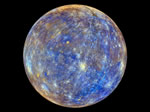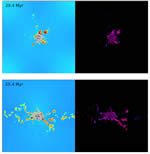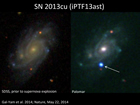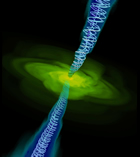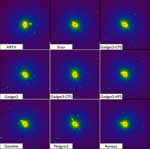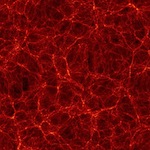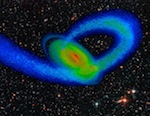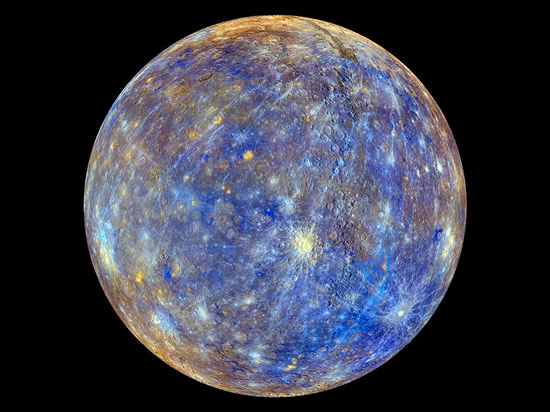Word doc
PDF (formatted and ready to go as a single newsletter page)
Mercury: Snow Globe Dynamo?
We already knew Mercury was bizarre.
A planet of extremes, during its day facing the sun, its surface temperature tops 800°F—hot enough to melt lead—but during the night, the temperature plunges to -270°F, way colder than dry ice. Frozen water may exist at its poles. And its day (from sunrise to sunrise) is twice as long as its year.
Mercury seen close-up from MESSENGER, with colors enhanced to emphasize the chemical, mineralogical, and physical differences among its surface rocks. Credit: NASA
Now add more weirdness measured by NASA’s recent MESSENGER spacecraft: Mercury’s magnetic field in its northern hemisphere is triple its strength in the southern hemisphere.
Numerical models run by postdoctoral researcher Hao Cao, working in the lab of Christopher T. Russell at UC Los Angeles, offer an explanation: inside Mercury’s molten iron core it is “snowing,” and the resultant convection is so powerful it causes the planet’s magnetic dynamo to break symmetry and concentrate in one hemisphere.
“Snowing” inside Mercury
With a diameter only 40 percent greater than the Moon’s, Mercury is the smallest planet in the solar system (now that Pluto was demoted). But its gravitational field is more than double the Moon’s. Why? Mercury has an absolutely gigantic iron core, accounting for 85 percent of the planet’s radius—about the size of the entire Moon. Only the planet’s outermost 15 percent is a silicate mantle.
Most of that iron is molten. Just the innermost core is solid: its size is unknown, but more on this in a bit. The molten iron is mixed with lighter elements, of which silicon and sulfur are most abundant. In 2008, other scientists showed that when iron is mixed with a lighter element under intense pressures likely reached partway inside Mercury’s molten core, there is a zone where solid iron will spontaneously precipitate in fine flakes like iron filings, drifting down like snow toward the solid core. At the same time, buoyant lighter elements will also separate from the iron as a liquid and will float upwards as fine droplets toward the mantle.
Inside Mercury there may be two distinct “snow zones.” In both cases, as solid iron falls and the lighter elements rise, their convective action stirs this gigantic molten iron core, bending and stretching magnetic field lines, driving an energetic planetary dynamo.
Planetary dynamos are thought to be helical (spiral) flows of a magnetized fluid along columns parallel to the planet’s axis of rotation; molten iron in the case of the rocky inner planets. A given column can spiral any of four combinations of directions: either clockwise or counterclockwise while flowing toward the poles or toward the equator. The question is what happens at the planet’s equator.
Spin flip
Inside Earth, in any single column both the northward and southward flows on both sides of the equator are spiraling in the same direction (say, clockwise and toward the equator). In a neighboring column, the flows all spiral in the opposite direction (say, counter-clockwise and toward the poles). That flow configuration is called an “even” mode.
If convective stirring is much stronger than Earth’s, fluid mechanics predicts that a planet’s molten iron core can also host an “odd” mode where the section of each column south of the equator spins in the opposite direction from the section north of the equator—that is, they reverse vorticity at the equator.
But the numerical simulations reveal that with really, really strong convective stirring—as would happen if a planet’s entire molten core is pervaded with convective iron snow—something dramatic happens: the odd and even modes overlap, spontaneously breaking symmetry and enhancing helicity in one hemisphere at the expense of the other.
“Unlike the Earth’s dynamo…, Mercury’s dynamo is likely powered by uniformly distributed buoyancy sources within the liquid core,” the authors conclude.
The model also predicts a size for Mercury’s inner core: small. In the simulations, a Mercury-like asymmetric magnetic field developed only when the solid inner core was less than half the radius of the molten outer core-mantle boundary. – Trudy E. Bell, M.A.Further reading: The paper by Cao and coauthors is “A dynamo explanation for Mercury’s anomalous magnetic field” in Geophysical Research Letters 41(2014):4127–4134. A review article is “Model dynamo may solve Mercury mystery,” by Ashley G. Smart, in Physics Today (August 2014) pp. 14–16. See also UCLA press release “Mercury’s magnetic field tells scientists how its interior is different from Earth’s” at http://newsroom.ucla.edu/releases/mercury-s-magnetic-field-tells-scientists-how-its-interior-is-different-from-earth-s.
The University of California High-Performance AstroComputing Center (UC-HIPACC), based at the University of California, Santa Cruz, is a consortium of nine University of California campuses and three Department of Energy laboratories (Lawrence Berkeley Laboratory, Lawrence Livermore Laboratory, and Los Alamos National Laboratory). UC-HiPACC fosters collaborations among researchers at the various sites by offering travel and other grants, co-sponsoring conferences, and drawing attention to the world-class resources for computational astronomy within the University of California system. More information appears at http://hipacc.ucsc.edu.
